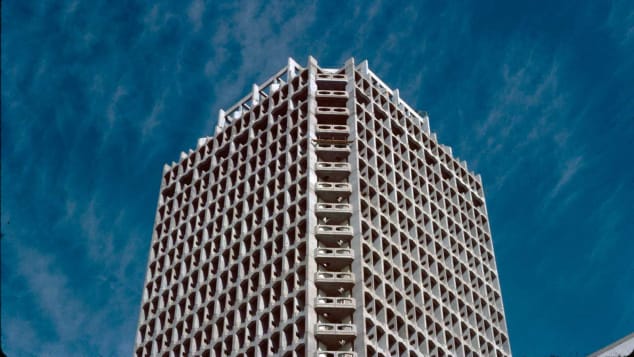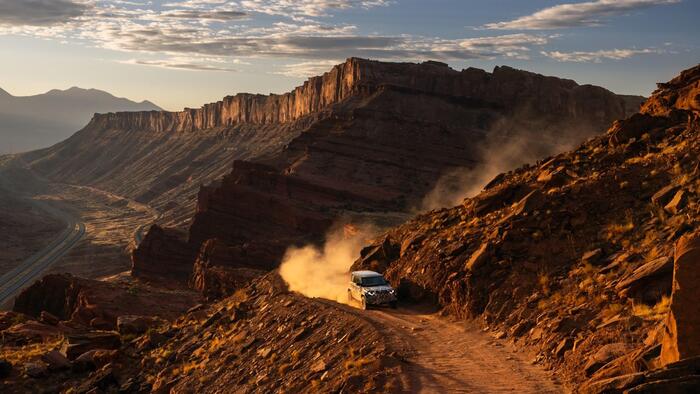This 1977 postcard photograph of the Dubai World Trade Center was taken by Stephen Finch, the tower's chief architect.Courtesy of Stephen Finch
(CNN) -
Dubai's skyline is adorned with record-breaking buildings.
From the world's tallest building, the 828-meter-high Burj Khakifa, to the world's tallest hotel, the 356-meter Gevora Hotel, the city is full of ambitious architectural projects.
These buildings are designed to give Dubai a reputation for architectural splendor, within the framework of the city's quest for international recognition, currently exemplified by the World Expo that will take place over the next five months.
However, Dubai's desire for attention is not new.
The desert city began to become an architectural landmark in the mid-1970s, when construction of the Dubai World Trade Center began, according to architect Todd Reisz, author of "Showpiece City: How architecture made Dubai."
Reisz is the curator of the exhibition "Off Center / On Stage", which runs until mid-February next year at the Jameel Art Center in Dubai.
It shows and recalls an older Dubai at the time it began its transformation into the city that it is today.
The exhibition includes photographs taken between 1976 and 1979 by British architects Stephen Finch and Mark Harris, who dedicated themselves to imagining, designing and realizing the future of the city, both being affiliated with John R. Harris & Partners, the British architecture studio which built the 149 meter high World Trade Center.
This 1977 postcard photograph of the Dubai World Trade Center was taken by Stephen Finch, the tower's chief architect.
Courtesy of Stephen Finch
Reisz said the words "On Stage" in the name of the exhibition refer to the "fact that the city has actually been on stage for decades. It has used exhibitions to promote itself and to attract people to live and invest in the city. That has been the way the city has really grown. "
advertising
World's tallest 360-degree infinity pool opens in Dubai
He added that as early as the 1960s, Dubai's leaders were promoting it in international newspapers, trying to convince people that it was the city of the future.
Beyond the "Dubai Creek"
When visitors enter the exhibition, they are greeted with a sweeping view of the “Dubai Creek” or Dubai Creek.
Less than 200 years ago, Dubai was a small fishing village and the body of water was nothing more than an estuary.
In the 1960s, it was an engineering canal, one of the city's first large-scale infrastructure projects, undertaken to help develop Dubai's reputation as a major commercial center.
The term 'off-center' refers to the fact that the city was for decades centered on the Dubai Creek, "Reisz said." The Dubai Creek was that defining geographic entity that allowed people to orient themselves.
In the 1970s, we began to see that there is a gradual but unstoppable movement away from the stream, especially towards the border with Abu Dhabi. "
"It doesn't start with the World Trade Center, but the World Trade Center complex is really the moment when this dynamism is defined so that the city moves out of the center."
Looking to the future
Many of the photos portray the people who were directly or indirectly involved in shaping the future of Dubai, from service sector workers to taxi drivers, Reisz said.
Although this future is always changing.
"There is always a kind of feeling that Dubai is like a big ad that says, 'Please excuse the mess, we are working on creating something bigger,'" he added.
"Many times, people look more towards what is to come and not look back at how we got to where we are today. For me it was very important to show that. Dubai is not a city that has emerged from the sands, it is a city that has emerged thanks to the people. People who have made decisions in their lives to contribute to the city in some way. "
The men in this 1977 image of the Dubai Creek look up at the City Hall building, which is under construction.
"You imagine it might be their second or third time in Dubai and they've seen the Dubai City Hall building get bigger every time they come ashore," said the exhibition's curator, Todd Reisz.
Courtesy of the John R. Harris Library
It was while writing "Showpiece City" that Reisz discovered the photographs, which are Kodachrome slides, a medium that captures the richness of colors.
"Even in broad daylight, the colors are so saturated and attractive that you can almost hear the images," says Reisz.
Although there are some aerial shots, most of the photos in the exhibition were taken from the ground, helping visitors see what it would have been like to walk around the city in the 1970s.
Reisz adds: "Every time I hear someone say, 'There was nothing here,' ... I want to argue with them. I think it's very important to understand that there was always something there."
"Whether it was minimal agriculture, trade routes running through parts of the coast, or settlements that had been there and been abandoned at some point, it's impossible to say there was nothing there. There has always been something." .
Dubai





/cloudfront-eu-central-1.images.arcpublishing.com/prisa/6HFG2OUUPVBT5MA3DAKSYGQJ5Q.JPG)









